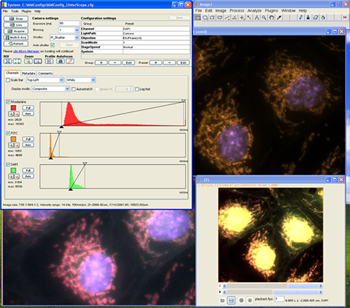|
|
μManager is a software package for control of automated microscopes. Together with the image processing application ImageJ, μManager provides a comprehensive, freely available, imaging solution. |
Download the most recent version (2.0) from our website. Also check out our ScreenCast for a quick tour on getting started.
|
|
μManager has a simple and clean user interface, through which it lets you execute common microscope image acquisition tasks such as time-lapses, multi-channel imaging, z-stacks, and combinations thereof. μManager works with microscopes from all four major manufacturers (Leica, Nikon, Olympus and Zeiss), most scientific-grade cameras and many peripherals (stages, filter wheels, shutters, etc.) used in microscope imaging (check the list of supported hardware). |
HOW IS μMANAGER DIFFERENT?
You have a choice of many commercial packages available, too many, perhaps. Some are produced by microscope or camera manufacturers, others by third parties but they all suffer from the same problems: lack of flexibility and limited device support…
IS μMANAGER FOR ME?
With the help of users world-wide μManager has been developed into a professional Microscopy software able to connect to a huge list of devices and effortlessly perform laborious acquisitions.
HARDWARE DEVICE SUPPORT
Whether you can use μManager right away or not depends on whether your particular hardware is supported. If not, contact us and express your desire. Check the current hardware list.
EXTENDING μMANAGER
Even if you are not interested in writing software code for your microscope, the open software architecture of μManager will benefit you. For instance, μManager’s open device interface lets anyone write code to control microscope-related equipment, resulting a large and growing list of supported equipment. A scripting interface makes it possible to accomplish tasks that can not be executed within the GUI. Lastly, the μManager programming interface can be used from many different environments (including Matlab) to develop new applications, all using the same μManager microscope device control.


